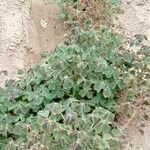Rhizomatous perennial herb; tubers numerous, elongated, to c. 12 × 4 cm, with reddish pink skin and yellow flesh; scales many, minute and in a long groove, otherwise tubers smooth and shining. Stems numerous, erect, to c. 75 cm tall, hairy, green or purple, succulent, moderately thick. Lvs 3-(4)-foliolate, cauline, white-pilose. Petiole 3-8 cm long, slender; stipules 5-8 mm long, adnate to petiole, membranous. Lamina of leaflets equal, sessile, 10-32 × 8-30 mm, broad-obovate, hairy, the hairs denser beneath; apex emarginate; calli 0. Fls few in cymes; peduncles to 11 cm long, ± hairy; pedicels to 10 cm long, densely hairy. Bracts 4-5 mm long, subulate; calli 0. Sepals 7-10 mm long, lanceolate, glabrous except at base and apex; calli 0. Petals c. 1.5 cm long, obovate, yellow with dark red veins, glabrous. Stamens at 2 levels; filaments dilated below, upper whorl hairy in lower 1/2. Styles of intermediate length between stamen whorls, hairy. Capsule not seen.
More
A small annual herb up to 30 cm high with leaves of 3 leaflets. The stems are round and succulent. The leaves are spirally arranged. The flowers are orange-yellow. Three different kinds of flowers occur associated with three different kinds of tubers. The tubers have scales which cover long deep eyes. Tubers vary considerably in shape. The tubers are wrinkled and vary in colour between red, orange, yellow, or white. Some varieties have bitter tubers. They are about 5-8 cm long and 2-4 cm across. The plant rarely sets seed in the field but seed can be produced by self pollinating. When seed form, they occur in 5 celled locules with 1-3 tiny seeds in each.
A temperate plant. It mostly grows in the Andes from Colombia to Chile at between 3,500 and 3,800 m altitude. The plant is frost hardy. They grow in the high altitude tropics. (2,800-4,560 m in the Andes). In Argentina it grows between 1,200-2,800 m above sea level. In the hot tropical lowlands, tubers perish quickly. A daylength of 9 hours is best for tuber formation. Vegetative top growth occurs under long day lengths. It suits hardiness zones 7-11.
More
Unknown in a truly wild situation, though plants have been found growing at heights up to 4,000 metres in the Andes.
Unknown in a truly wild situation, though plants have been found growing at heights up to 4000 metres in the Andes.


